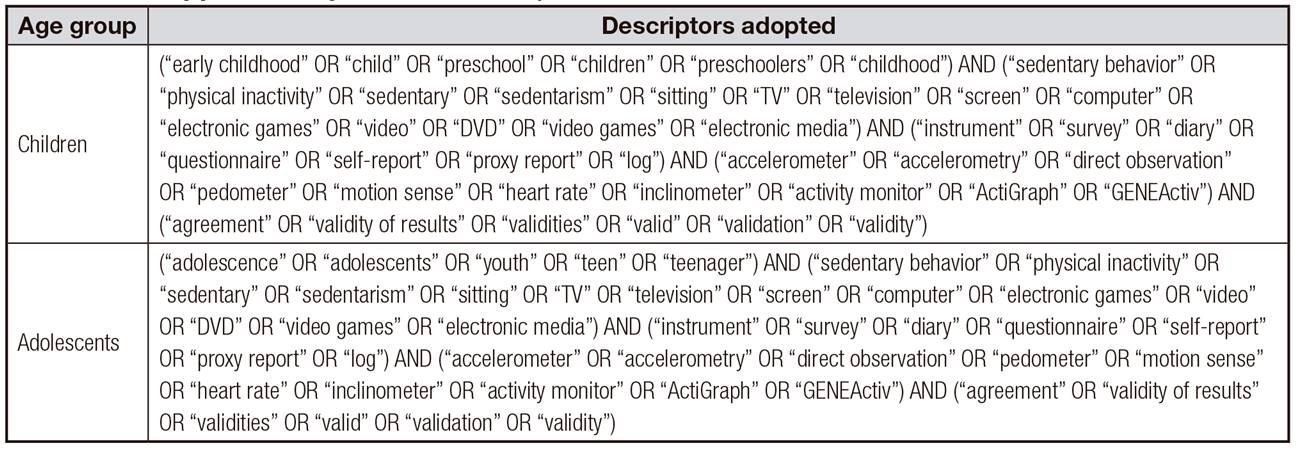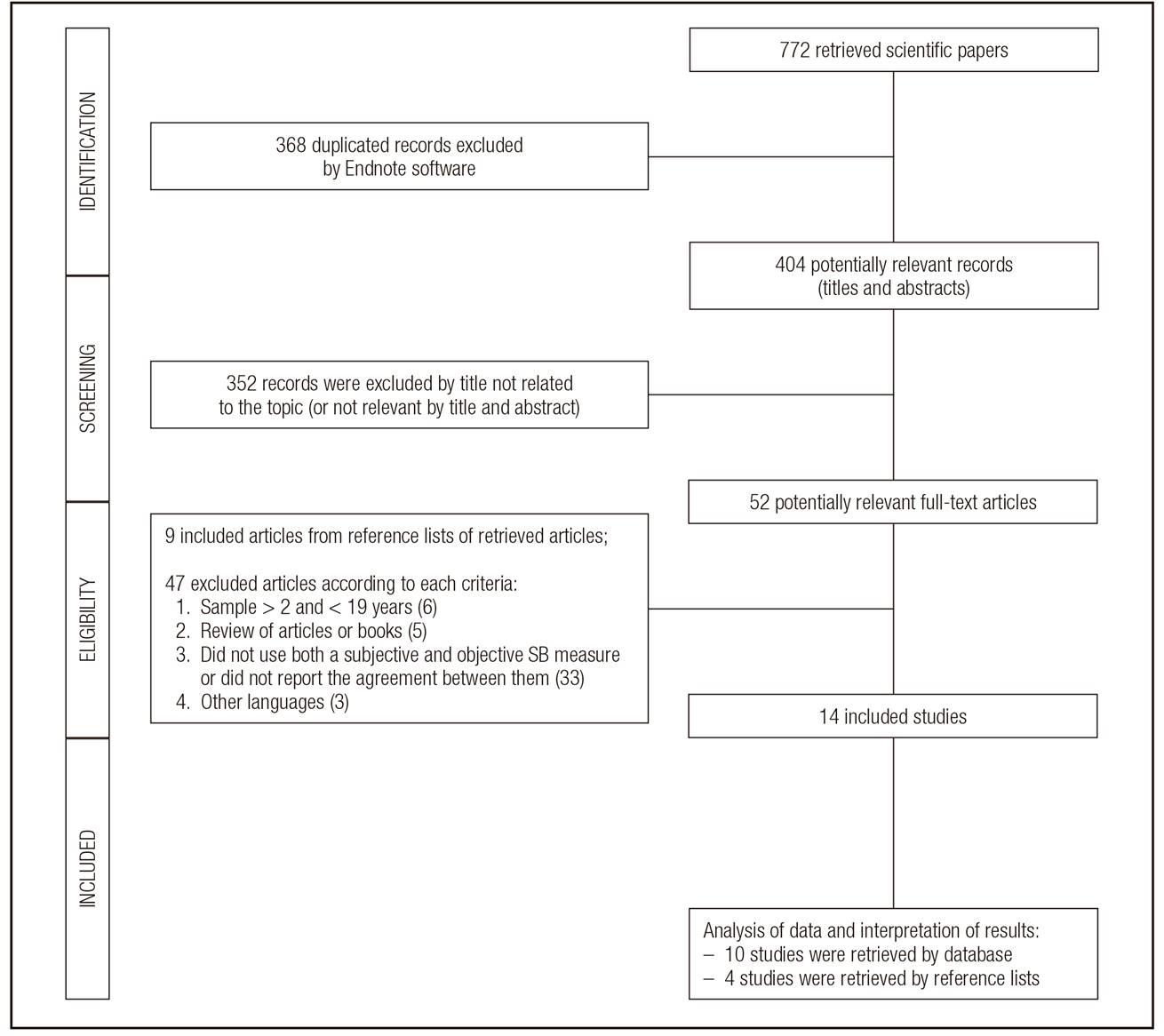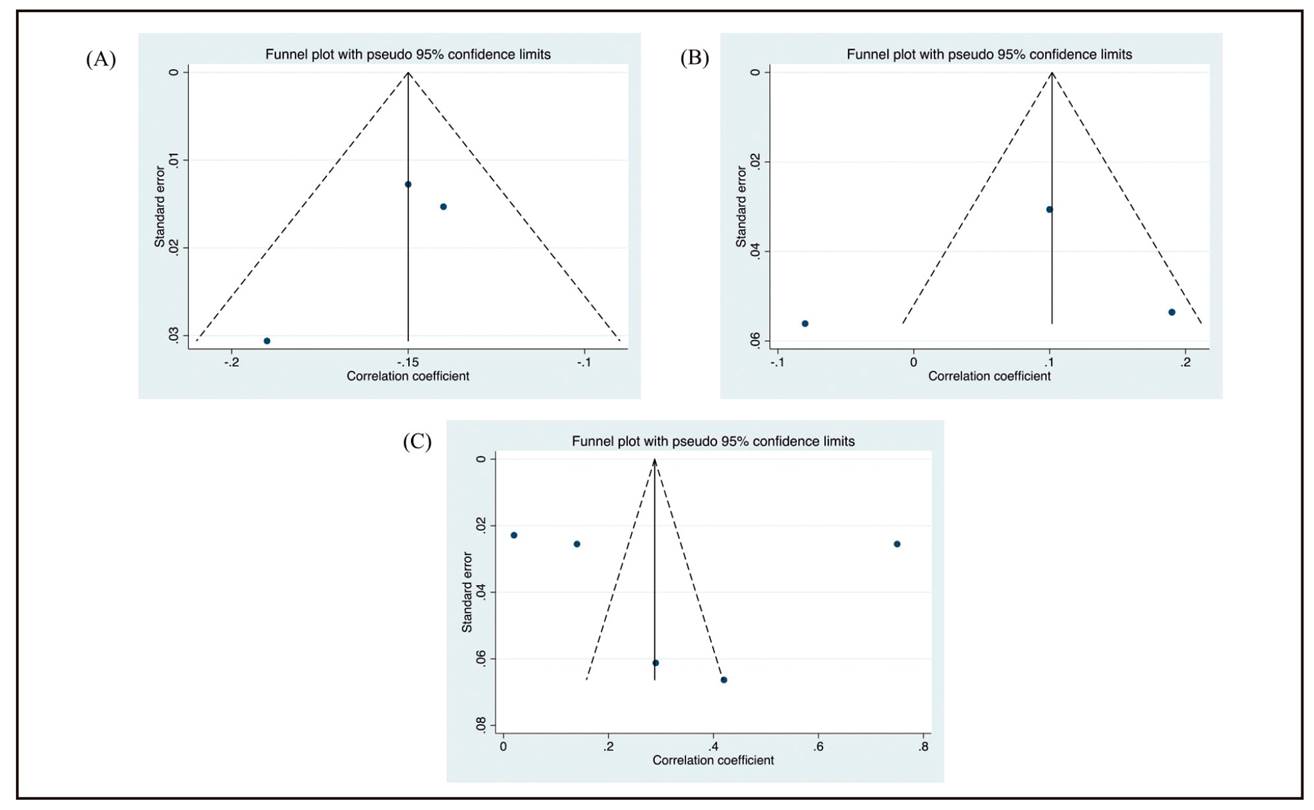INTRODUCTION
Sedentary behavior is defined as activities performed in a seated or lying posture with very low energy expenditure 1. In youth, these activities are associated with health outcomes, such as obesity 2,3, cardiovascular disease and metabolic syndrome 4,5,6,7. Currently, it is estimated that children spend 1.5-3.0 hours per day in front of a screen (e.g., television, video games) (8). Children considered to be "high users" at young ages are likely to maintain this status when they are older 8. In this sense, the control of sedentary time (e.g., screen time, sedentary behavior) has been shown to be a promising approach to maintaining health 9,10.
Quality instruments for assessing sedentary time with well-known accuracy in youth are vital for understanding dose-response relationships between sedentary activities and health outcomes as well as health monitoring, estimating prevalence and trends, and determining the correlates and predictors of these activities and the impact of health interventions 11,12. Sedentary time can be estimated using objective methods 13,14. However, they are often not available for epidemiological studies 11,15,16, primarily because of the logistic and economic costs.
In this scope, questionnaires and diaries (subjective methods) have emerged as feasible alternatives 12,15. These methods rely on information obtained from parents for collecting data on their children, or directly from adolescents 2,11,15. These methods are low cost, easy to administer, and they are usually applied in large-scale studies 11. Questionnaires and diaries also have the advantage of capturing the type (e.g., TV viewing) and context (e.g., at home) of activities, which may identify potential key targets for designing effective interventions 11,12,13,15.
Because the application of questionnaires and diaries to evaluate sedentary time in children and adolescents has increased, several systematic and descriptive reviews have compared the agreement between subjective and objective methods 11,12,13,17, which were interpreted as constructs, criteria and/or convergent validity 13. The current literature indicates there is limited agreement between questionnaires and diaries for assessing sedentary time 11,15,17. Although the methodological challenges of measuring sedentary time have been thoroughly discussed 12,15,17, the literature provides little empirical evidence of how to design subjective methods and formats (e.g., questionnaire or diary) as well as what reference method and strategies for data recording can improve the agreement 13. In this systematic review, we aimed to provide evidence to support decisions about measurement approach choices for subjectively assessing sedentary time in children and adolescents, adopting objective methods as the reference.
METHODS
SEARCH STRATEGY
Searches were performed using the electronic databases Medline (PubMed), Web of Science, Embase, SPORTDiscus, BioMed Central and SCOPUS. These databases were searched for records from their inception up until the most recently published articles in January 2016. The present review is registered in the PROSPERO database (CRD42014015138).
Descriptors and the MeSH terms "sedentary behavior", "questionnaire", "diary" and "validity" were used as search terms in the databases. The search strategy was applied twice, once for children (adding descriptors for "children") and once for adolescents (adding descriptors for "adolescents"), as seen in Supplementary Table I. Additionally, the references listed from the articles found in these databases were reviewed, and the corresponding authors of unavailable articles were directly contacted. We also checked the reference lists of other relevant studies, key articles and previous reviews 11,12,15,18.
ELIGIBILITY AND EXCLUSION CRITERIA
The inclusion criteria were as follows: a) studies defining sedentary activity as any waking behavior characterized by activities with an intensity less than 1.5 metabolic equivalent (MET, a resting energy expenditure set at 3.5 ml of oxygen/kg of body mass/min) 1 or a combination of low-intensity activities (≤ 1.5 MET) conducted in a seated or reclining posture 19; b) studies with participant populations composed of children (2-10 years) and/or adolescents (11-19 years), as defined by the World Health Organization (WHO) 20; c) studies containing original research; d) studies performed with at least one subjective measurement and one objective measurement for sedentary activity; e) studies reporting at least one agreement measure for subjective and objective methods; and f) publications written in English, Spanish or Portuguese.
The exclusion criteria were as follows: a) studies considering sedentary activity to be physical inactivity; b) participants aged out of 2 to 19 years; c) study participants with different diseases or disturbances that could interfere with sedentary behavior; d) studies including only children and/or adolescents with disabilities or developmental delays that may impact their ability to accurately recall subjective information; and e) studies that reviewed articles or books. These criteria were set to increase inter-study comparability.
SCREENING PROTOCOL
In the screening phase, potentially relevant papers were selected first by screening the titles and then by screening the abstracts, and if the abstract did not provide sufficient data, then we retrieved and screened the entire article. Two authors (Nascimento-Ferreira, M. and Toazza, P.) independently performed the literature screening using a pre-defined study extraction form. The results were compared and if a disagreement occurred, then the article was evaluated by a third researcher (De Moraes, AC.) (Fig. 1).
DATA EXTRACTION
The extracted publication data form included study characteristics (such as the authors, tool assessed, location, publication year, population, respondent), the sample size, the duration of sedentary activity recording, the test-retest interval, the subjective and objective methods, the measurement units, the test-rest reliability assessed (if conducted) and the estimated effect for agreement between subjective and objective method.
We considered the estimated effect for agreement of the key variable (indicated in each study aim) of the subjective method, or we selected the variable associated with the largest set of sedentary activities. We considered more than one validity estimate effect per study if global estimate effects were not provided. In studies with stratified validity estimate effects, a pre-specified priority order of study population (children, adolescents), type of measurement (e.g., screen time, sedentary behavior), subjective method (questionnaire, diary), objective method (e.g., accelerometer, direct observation) and type of report (e.g., parent-report, self-report) was used to assess inclusion.
DATA SYNTHESIS
The Pearson correlation coefficient and the Spearman (rank) correlation coefficient were selected as the operationalization for the agreement estimate effects in the meta-analysis. At least three agreement measures from two different studies were required in each meta-analysis. Agreement measures that used other statistical estimate effects (e.g., Bland-Altman, t-test, limits of agreement) were retrieved, and the estimate effects were identified. However, these estimate effects were not included in the meta-analysis 21.
OUTCOMES AND INDEPENDENT VARIABLES
Agreement is the degree to which scores or ratings are identical 22. We adopted the correlation coefficients of the agreement between the subjective and objective methods (reference method) that were assessed at the same time as the outcome. The independent variables were the measurement approaches: type of measurement, subjective method, objective method and type of report.
ASSESSMENT OF METHODOLOGICAL QUALITY
We used the checklist proposed by Kmet, Lee and Cook 23 to examine methodological quality. Studies were scored according to eleven items (items 5, 6 and 7 were not applicable) from 14 items, depending on the degree to which the specific criteria (item) were met ("yes" = 2 points, "partial" = 1 point, "no" = 0). Then, the sum of all scores was divided by the highest possible score (28 points), which yielded quality scores ranging from 1 (best) to 0 (worst). Items not applicable to a particular study design were excluded from the calculation of the summary score. Two authors (Nascimento-Ferreira, M. and Toazza, P.) independently performed the methodological quality assessment and disagreements were discussed with a third author (Rendo-Urteaga, T.).
STATISTICAL ANALYSIS
The Stata 14 (Stata Corp., College Station, TX, US) program was used for statistical analysis. The sensitivity analyses between total agreement estimates and estimates that reported correlation coefficients were performed by Chi-square goodness of fit test. The significance level was set at p ≤ 0.05. The pooled correlation coefficient was performed by meta-analysis with a random-effects model for moderate-to-high heterogeneity and a fixed-effects model for low heterogeneity 24. Additionally, forest plots were constructed. We calculated the coefficient with corresponding 95% confidence interval (CI) across individual studies, which were organized according to sedentary activity group. The heterogeneity of studies was evaluated using an I2 test (values of p < 0.05 were considered significant). To verify potential publication bias (i.e., systematically positive or negative results) and small-study effects, the Egger test was performed 25. In this regression, a bias value of p < 0.05 indicates the presence of asymmetry, and the sign of the coefficient indicates the direction 26. Funnel plots were generated to examine the potential bias graphically.
A value of 0% indicates no observed heterogeneity, whereas values of 25%, 50% and 75% were considered as low, moderate and high, respectively 27. To estimate the strength of the agreement, the correlation coefficient (Pearson correlation and/or Spearman rank) cut-off points were defined using the following classification: 0-0.19, very weak; 0.2-0.39, weak; 0.40-0.59, moderate; 0.6-0.79, strong; 0.8- 0.9, very strong; and 1.0, perfect correlation 28.
RESULTS
The literature search yielded 772 titles of potentially relevant articles (98.8% from electronic databases and 1.2% from references or other reviews). Of those titles, 14 studies 29,30,31,32,33,34,35,36,37,38,39,40,41,42 were eligible according to the established inclusion/exclusion criteria (Fig. 1). All of the included studies were published after 1984. The number of papers about the agreement between questionnaires and diaries with objective methods increased after the year 2010. A small portion of the retrieved studies were performed only in one sex (14.3%). A total of 5,703 youth (mean per study = 312; range = 34-2,048) with ages ranging from 3 to 17.5 years were evaluated. The methodological quality scores of the studies were acceptable (≥ 0.64 in all studies) (Supplementary Table 2) 23.
Supplementary Table II Extracted data about demographic characteristics, methodological approach, correlation coefficients and methodological quality assessment of the studies
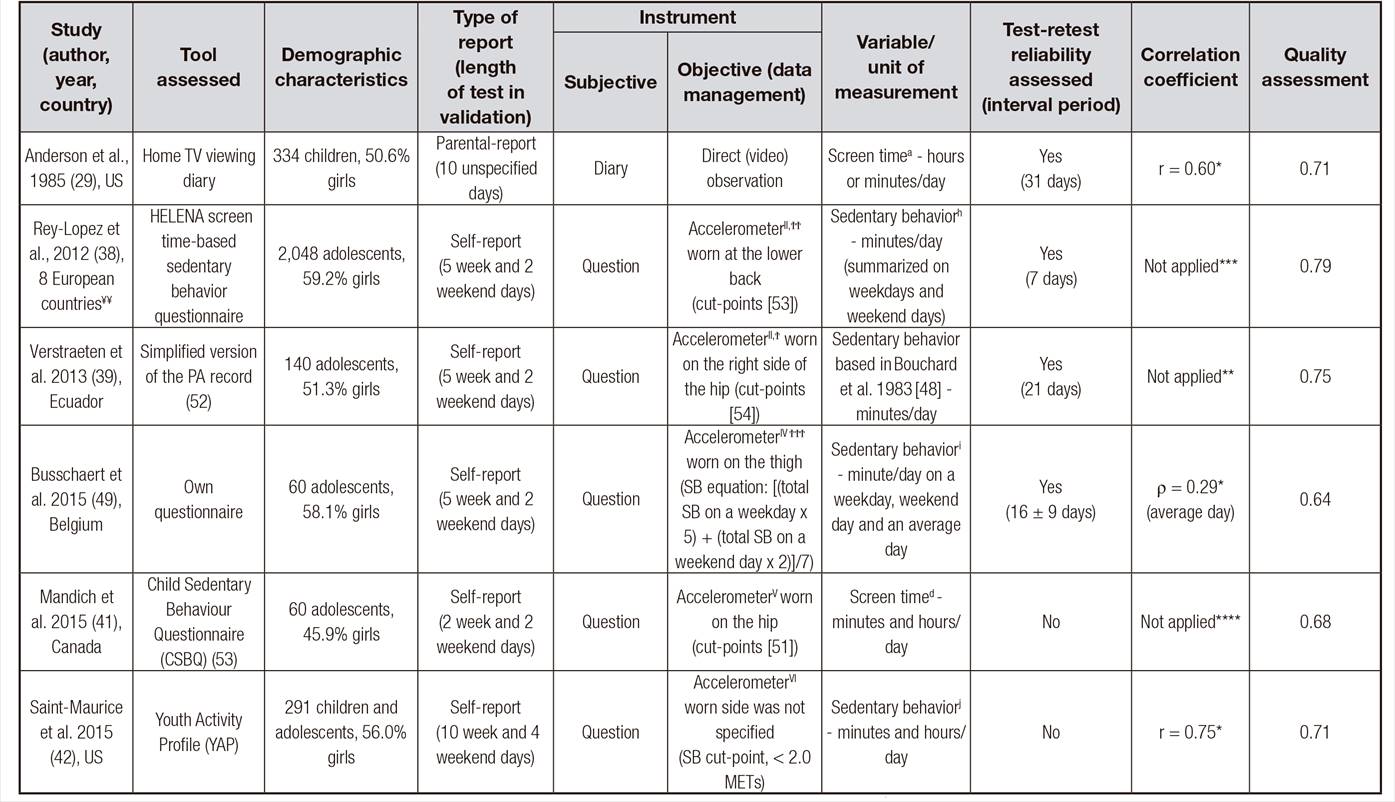

HELENA: Healthy Lifestyle in Europe by Nutrition in Adolescence; Question.: questionnaire; SB: sedentary behavior; US; United States. aTV viewing. bTV viewing and using a computer. cTV viewing, playing video games, using a computer, doing homework/study, reading, talking on the phone, sitting, doing hobbies, music practice, travelling in a car, bus ferry or train and going to the cinema. dTV viewing, playing games and using a computer. eTV viewing, playing games, using a computer, playing indoors in a stationary way, reading, sitting and sleeping or napping during the day. fTV viewing, playing games, using a computer and talking on the phone. gTV viewing, playing games, using a computer, doing homework, reading, playing a musical instrument, playing quietly and performing other quiet activities. hTV viewing, playing games (consoles and computer), internet for study (and non-study) and study. iTV viewing, playing (video)games, using a computer, using a cell phone, and also include an overall sedentary time item. jTV viewing, playing games, using a computer, in motorized transport and school. ICaltrac, Muscle Dynamics, California, US. IIActigraph, MTI, Florida, US. IIIDigiwalker, Yamax, Japan. IVActivPAL(tm) 3MHealthcare, Minnesota, US. VActical, Philips Respironics, Oregon, US. VISenseWear Armband Pro3 (SWA), BodyMedia, Pittsburgh, US. ϮDevice was removed when sleeping or in a water activity. evice was removed when in water activity. Device was used in full time. ¥7 days in winter of 2004 and 7 days in spring of 2005. ¥¥Austria, Belgium, France, Germany, Greece, Hungary, Italy, Spain, Sweden. ŦValues adjusted by sex, maternal education and school grade. ŦŦValues adjusted by sex and maternal education. *p < 0.05. **In this study the criterion validity was analyzed based on Bland-Atman plots (level of agreement). ***In this study the criterion validity was analyzed based on Kruska-Wallis (mean difference). ****In this study the criterion validity was analyzed based on paired t-test (mean difference).
Two major groups of sedentary activities were found: screen time and sedentary behaviors (i.e., several sedentary activities including screen time). Sedentary behaviors varied from only one sedentary activity 29 to 13 sedentary activities 33 that were measured. Additionally, three objective methods were used, including direct observation, accelerometers and pedometers, along with two subjective methods: questionnaires and diaries (Table 2).
The most common study characteristics were that the studies were performed after 2010 in North America and focused on adolescents. In addition, the most common methodological approaches included sedentary behavior (comprising screen time) as the main measurement, which was assessed through self-reported questionnaire and compared with accelerometer (Table 1).
Table I Descriptive characteristics of the agreement estimates
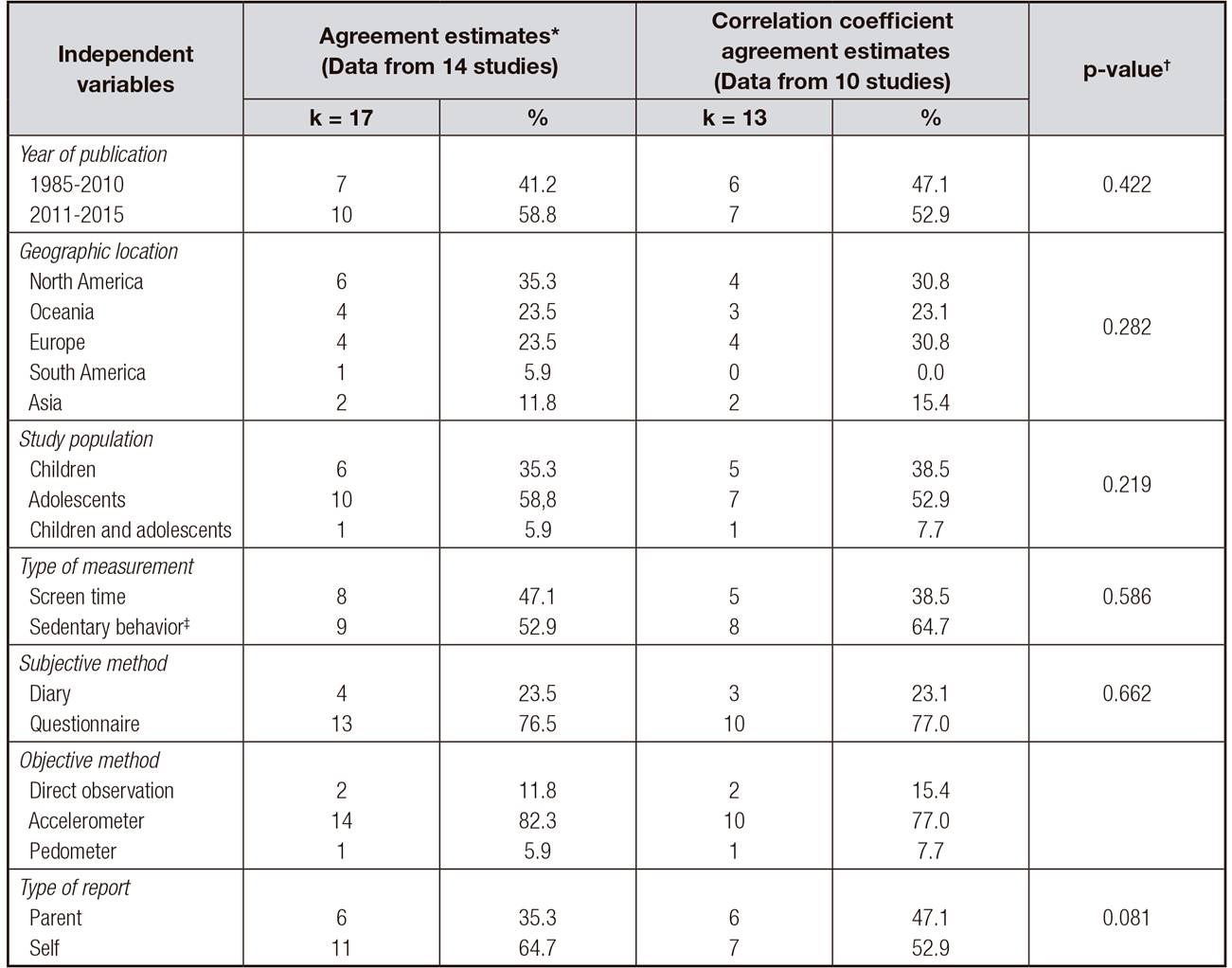
k: number of agreement analyses. Significant values (p < 0.05) are in bold. *Total agreement estimates, including other statistical test as t-test, ANOVA, linear regression and Bland-Altman method. †Chi-square goodness of fit (p-value) for comparison between total studies (k = 17) and studies that reported correlation coefficients (k = 13). ‡Including screen time.
Regarding the sensitivity analysis, significant differences were found among independent variable proportions between studies that reported or did not report correlation coefficients (Table 1). Seventeen agreement measures were found from 14 studies. Of these measurements, 13 agreements were measured by coefficients of correlation (Pearson or Spearman coefficient) from ten studies (76.5%). In addition, two agreement measures from only one study were based on adjusted results for sex, school and maternal education and four agreement measures from four studies were presented by other statistical estimated effects (Bland-Altman plots; and t-test and Kruskal-Wallis mean differences), and they were not included in the meta-analysis (Supplementary Table 2).
Two meta-analyses based on data synthesis inclusion criteria with methodological quality scores of ≤ 0.71 and ≤ 0.68 for screen time and other for sedentary behavior, respectively, were performed. A negative pooled correlation coefficient of -0.15 (n = 1,690; CI 95%: -0.17 to -0.13) was identified for the agreement between questionnaires and accelerometers for assessing self-reported screen time. Conversely, positive correlation coefficients of agreement were found between questionnaires and accelerometers for assessing parent-reported (n = 201; r = 0.09, CI 95%: 0.04 to 0.13) and self-reported (n = 551; r = 0.43, CI 95%: 0.40 to 0.47) sedentary behavior (Fig. 2). The meta-analysis showed significant heterogeneity (I2 ≤ 84.3%) across studies for the assessment of sedentary behavior.
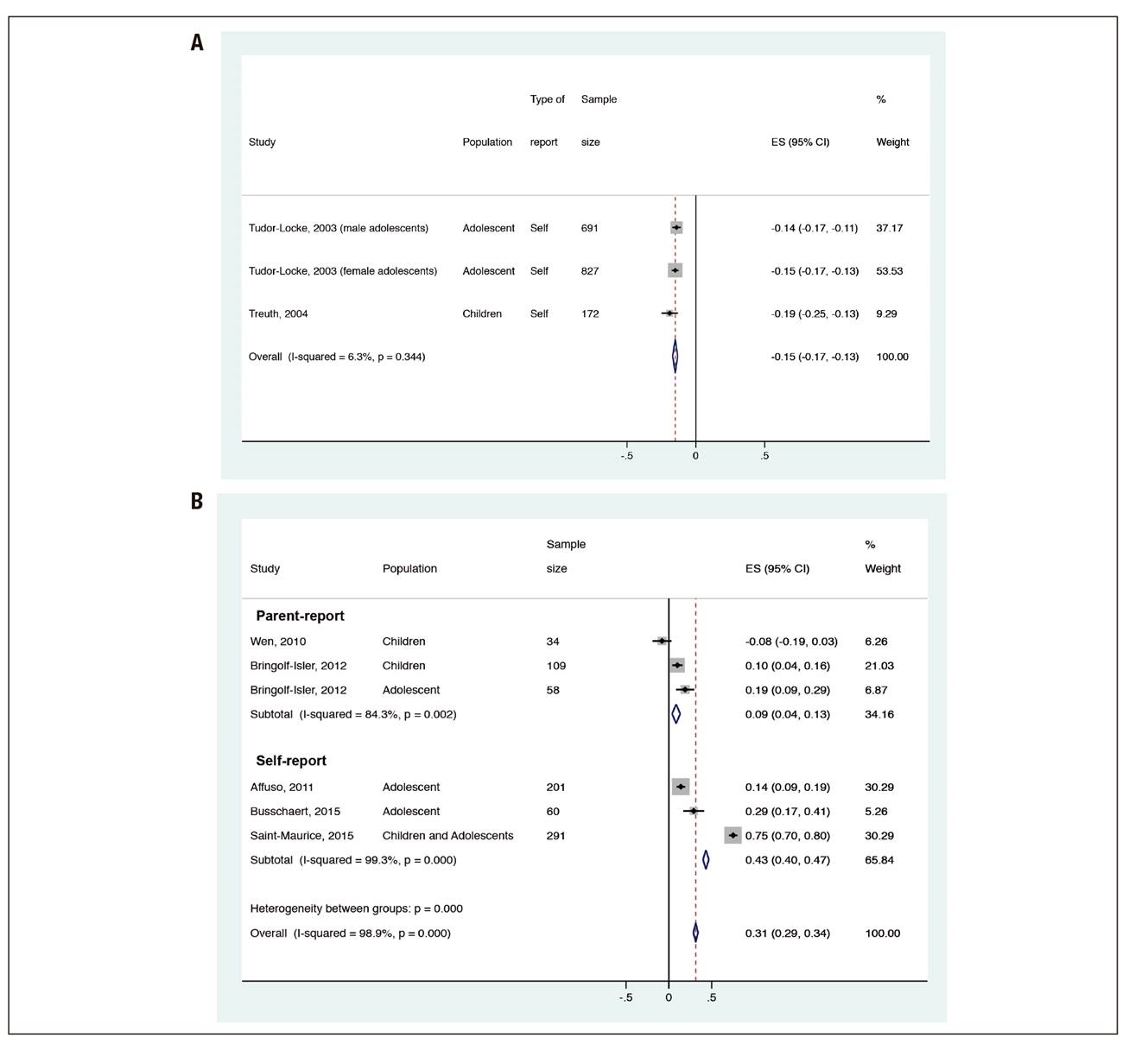
Figure 2 Meta-analysis summary for screen time (self-reported, A) and sedentary behavior (parent- and self-reported, B) assessed by questionnaires and accelerometers (ES: effect size of correlation coefficient; CI: confidence interval; I-squared (I2): statistical index of heterogeneity).
No asymmetric distribution was found because the intercept (bias) was near zero (p ≤ 0.05), and we did not find any significant small-study effects (p ≤ 0.05) 25. These potential biases were also tested graphically in the funnel plots that are shown in the supplementary file (Supplementary Fig.1) and similar findings were observed.
DISCUSSION
In our opinion, the selection of the design for agreement studies will be primarily driven by the study's aim and the resources available. However, the findings from this systematic review should be considered as the beginning of what we expect will be a body of evidence regarding the impact of decisions about election of type of measurement, subjective method, objective method and type of report in the agreement between subjective and objective methods for assessing sedentary time in children and adolescents. The novel finding based on our evidence is that questionnaires have positive agreement with accelerometers for assessing sedentary behavior, whereas the agreement is negative for the assessment of screen time. In this sense, self-reported questionnaires may be considered to be useful methods when the main goal is to assess sedentary behavior, especially in adolescents.
SUMMARY OF FINDINGS
We identified agreement measurements from five continents, and all those studies were written in English and published after 1984. There has been a substantial increase in these types of publications over the last ten years. Historically, sedentary time was conceptualized as a part of the physical activity spectrum 5,43. In this sense, the recent increase in the number of sedentary time method agreement studies could be explained by the consideration of sedentary time as a behavior that is separate from physical activity 5.
We found publications that used direct observation, accelerometers and pedometers as reference methods to assess sedentary time. Prior to 2006, we found studies evaluating only screen time (e.g., watching TV, using a computer, playing video games). After this period, other behaviors (e.g., reading, talking on the phone, sitting, music practice, travelling in a car) were included in the sedentary behavior questionnaires and diaries, which provided a more comprehensive understanding of this behavior beyond screen time 9,10 because screen time alone did not appear to be representative of the overall sedentary time 44.
MAJOR FINDINGS FROM THE META-ANALYSIS: AGREEMENT BETWEEN QUESTIONNAIRES AND ACCELEROMETERS FOR ASSESSING SCREEN TIME
Based on the meta-analysis correlation coefficients, our findings showed that the agreement between questionnaires and accelerometers for the assessment of self-reported screen time in children and adolescents was negative. These findings are similar to a previous systematic review that showed that agreement for self-reported screen time was r = 0.07 15. However, in this review, the authors included direct observation as a reference method, which could improve the results.
Two other recent reviews of the literature 11,15 indicate that the agreement of children's self-reported TV viewing with objective methods is highly variable (r = -0.19 to 0.88) 12. The negative agreement found in our review could be partially explained because accelerometers, in general, assess the absence of movements with limitations to evaluate aspects related to the type of sedentary activity that is being performed 12,13. On the other hand, the questionnaires cover specific questions 15 about TV viewing, computer use and playing video games. Thus, studies drawing inferences about total sedentary time (from accelerometers) compared to a set of behaviors relative to screen time (from questionnaires or diaries) should be interpreted with caution.
Alternatively, the literature suggests direct observation as the gold standard for assessing screen time 15. We found two studies (which were not meta-analyzed) that compared questionnaires 32 and diaries (29) with direct observation, and they found moderate (r = 0.49) to strong (r = 0.60) correlation, respectively. However, this methodology could be invasive and not practical for large-scale research studies 11,15. In this sense, we speculate that the poor agreement between questionnaire and accelerometer for assessing screen time found in the meta-analysis could be likely due to the choice of accelerometers as a reference method rather than the subjective method per se.
MAJOR FINDINGS FROM THE META-ANALYSIS: AGREEMENT BETWEEN QUESTIONNAIRES AND ACCELEROMETERS FOR ASSESSING SEDENTARY BEHAVIOR
Our results suggest that there is positive agreement between questionnaires and accelerometers for assessing sedentary behavior. In addition, we found moderate correlation when the information was self-reported by adolescents. In this topic, the literature has no a clear line, although one systematic review 17 indicates that there is no acceptable agreement between objective and subjective methods due to the low methodological quality of the included studies or to poorly developed questionnaires. On the other hand, a classic systematic review (11) states that subjective methods provide reliable estimates of sedentary behavior and accelerometers can accurately classify participants' behavior as sedentary. There, the authors recommend the use of accelerometers in conjunction with subjective measures to assess sedentary behavior.
In our systematic review, all questionnaires assessed the time spent in sedentary behavior. One potential explanation for the findings in the current review and which can complement previous reviews 11,17 is based on a recent study by Kelly et al. 13, who hypothesized that there is no single "gold standard" for sedentary behavior measurement and measurement depends primarily on the aspect of interest that there will be different best reference methods. Therefore, for total volume (or absence) of activity, accelerometers may be the most adequate reference method 13,45, which could have approximate the measures from questionnaires and accelerometers providing positive correlation.
However, it is important that researchers, practitioners and policy makers understand the strength and limitation of the methods 46. In general, accelerometers do not assess changes in posture 47, but they capture the lack of movement 13 or the accumulation of low movement counts at specified cut-points 12. Additionally, there are different cut-points, axes, degrees of data reduction, and data management applied to identify sedentary time 15.
Furthermore, we found that the questionnaires, especially for adolescents, were frequently answered by the participant, whereas for children, the questions were answered by their parents. In addition, according to the literature, self-reporting may not be appropriate for children due to their limited cognitive capacity, which may hinder accurate recall 12. Under such circumstances, parental reports may be used to gather information on children's sedentary behavior 48. Regarding adolescents, some original studies have shown that parents can overestimate the behaviors of adolescents 49,50. However, few studies have examined the psychometric properties of sedentary behavior self-reports of children or adolescents compared to parental reports 12.
HETEROGENEITY AND POTENTIAL BIAS IN THE META-ANALYSIS
An important heterogeneity was found for assessing sedentary behavior, which was commonly observed in other meta-analyses that addressed this or similar topics 5,51. The heterogeneity can be partially explained by the large age range of the subjects as well as the different questionnaires and accelerometers that were adopted, the number of days that accelerometers were worn, different accelerometer cut-off and axis points, questionnaire attributes (e.g., length of recording period, number of items), and the different geographic populations. For these reasons, we were not able to perform a meta-regression to assess potential sources of heterogeneity due to differences among study methodologies 52.
Regarding bias, although the scientific community seems to be resistant to published studies with negative and non-significant results 25, our analysis did not indicate a potential risk of bias towards publications with significant and positive results. Additionally, we did not find small-study effects for the agreement measures. However, we can speculate there were two potential biases, including publication bias and location bias. Although we observed an increase in the number of published studies, these studies were published only in English, and the majority of these studies were performed in high-income continents (North America and Europe) 53.
STRENGTHS AND LIMITATIONS
The present study has several strengths. This review was systematically conducted by multiple reviewers. We retrieved a large number of studies from different continents using a thorough search procedure that covered a period greater than 30 years. The Preferred Reporting Items for Systematic Reviews and Meta-Analyses (PRISMA) statement 54 was adopted, and a methodological quality rating was performed separately to assist with interpreting the findings. In addition, based on a cross-reference search of published reviews, studies that were not found in the electronic database searches were included. Another strength of this review was that two independent authors conducted the data extraction and the methodological quality assessment.
We are confident that our findings were able to obtain an adequate representation of the literature available on the agreement of sedentary behavior questionnaires and diaries with objective methods. Additionally, this is the first time that results on the agreement between questionnaires and accelerometers for assessing screen time and sedentary behavior, respectively, were summarized in a meta-analysis as well as the first assessment of how measurement approaches can be associated with the referred agreements.
The limitations of this review include some different classifications of sedentary behavior among the questionnaires 5,19, especially because sedentary behavior was considered to be part of the physical activity spectrum for several years 5. To avoid these potential misclassifications, we included only subjective methods that used two accepted definitions of sedentary behavior 19. Due to the nature of the measurements, the agreement between questionnaires and accelerometers for assessing screen time and sedentary behavior found in our meta-analyses cannot be extrapolated for metrics (e.g., energy expenditure, metabolic rates) other than sedentary time.
Studies addressing other types of agreement analyses, such as subjective or health outcomes, as reference methods were not assessed. The variations in methods in studies comparing subjective and objective methods should be considered as a limitation, such as differences in the cut-off points, axis or vector magnitude used to analyze accelerometer data and the fact that subjective (reported time in behavior) and objective (total time in absence of movement) methods did not measure exactly the same parameters. Other potential limitations can be the agreement analyses restricted to data from published studies. No data was retrieved from gray literature or similar sources.
Other important limitation comprises correlation coefficients as agreement estimates. Summarizing the findings on agreement between methods is complex 55, especially because several statistical procedures were adopted. In our meta-analyses, only correlation coefficients were considered, which implies that caution should be taken when accepting agreement with only a supporting statistical test 56. However, correlation coefficients are the most common estimated effects used to examine agreement between medical methods 57, and they are considered as good indicators of the relationship between two instruments 28. In addition, we have no meta-analyzed findings about diaries, as well as we have no meta-analyzed addressing other objective method as reference method than accelerometer.
Despite all these limitations, the results of the present study were the best estimate that could be produced with the available evidence on the agreement between subjective and objective methods for assessing screen time and sedentary behavior. Finally, our systematic review was not designed to indicate an ideal methodological approach for agreement studies in sedentary behavior but rather to provide an initial discussion based on evidence about the impact of methodological decisions in the agreement studies.
CONCLUSIONS
There are two major groups of activities used to measure sedentary time subjectively: screen time and sedentary behavior. Questionnaires have positive agreement with accelerometers for assessing sedentary behavior. Conversely, the agreement between the questionnaires and accelerometers for screen time is negative. Self-reported questionnaires are recommended methods to measure sedentary behavior in adolescents.













